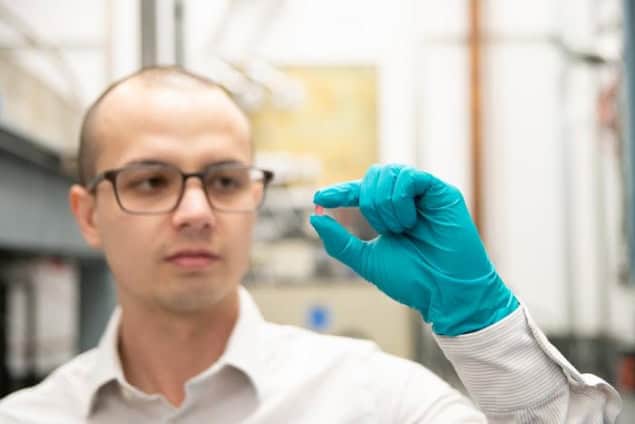Quantum Barkhausen noise detected for the first time
19 Apr 2024 Isabelle Dumé
Listen up: Team member Christopher Simon holds a crystal of lithium holmium yttrium fluoride, a material that produces quantum Barkhausen noise. (Courtesy: Lance Hayashida/Caltech)
Researchers in the US and Canada have detected an effect known as quantum Barkhausen noise for the first time. The effect, which comes about thanks to the cooperative quantum tunnelling of a huge number of magnetic spins, may be the largest macroscopic quantum phenomena yet observed in the laboratory.
In the presence of a magnetic field, electron spins (or magnetic moments) in a ferromagnetic material all line up in the same direction – but not all at once. Instead, alignment occurs piecemeal, with different regions, or domains, falling into line at different times. These domains influence each other in a way that can be likened to an avalanche. Just as one clump of snow pushes on neighbouring clumps until the entire mass comes tumbling down, so does alignment spread through the domains until all spins point in the same direction.
One way of detecting this alignment process is to listen to it. In 1919, the physicist Heinrich Barkhausen did just that. By wrapping a coil around a magnetic material and attaching a loudspeaker to it, Barkhausen transformed changes in the magnetism of the domains into an audible crackling. Known today as Barkhausen noise, this crackling can be understood in purely classical terms as being caused by the thermal motion of the domain walls. Analogous noise phenomena and dynamics also exist in other systems, including earthquakes and photomultiplier tubes as well as avalanches.
Quantum Barkhausen noise
In principle, quantum mechanical effects can also produce Barkhausen noise. In this quantum version of Barkhausen noise, the spin flips occur as the particles tunnel through an energy barrier – a process known as quantum tunnelling – rather than by gaining enough energy to jump over it.
In the new work, which is detailed in PNAS, researchers led by Thomas Rosenbaum of the California Institute of Technology (Caltech) and Philip Stamp at the University of British Columbia (UBC) observed quantum Barkhausen noise in a crystalline quantum magnet cooled to temperatures near absolute zero (- 273 °C). Like Barkhausen in 1919, their detection relied on wrapping a coil around their sample. But instead of hooking the coil up to a loudspeaker, they measured jumps in its voltage as the electron spins flipped orientations. When groups of spins in different domains flipped, Barkhausen noise appeared as a series of voltage spikes.
The Caltech/UBC researchers attribute these spikes to quantum effects because they are not affected by a 600% increase in temperature. “If they were, then we would be in the classical, thermally activated regime,” Stamp says.
Rosenbaum adds that applying a magnetic field transverse to the axis of the spins has “profound effects” on the response, with the field acting like a quantum “knob” for the material. This, he says, is further evidence for the novel quantum nature of the Barkhausen noise. “Classical Barkhausen noise in magnetic systems has been known for over 100 years, but quantum Barkhausen noise, where domain walls tunnel through barriers rather than being thermally activated over them, has not, to the best of our knowledge, been seen before,” he says.
Co-tunnelling effects
Intriguingly, the researchers observed spin flips being driven by groups of tunnelling electrons interacting with each other. The mechanism for this “fascinating” co-tunnelling, they say, involves sections of domain walls known as plaquettes interacting with each other through long-range dipolar forces. These interactions produce correlations between different segments of the same wall, and they also nucleate avalanches on different domain walls simultaneously. The result is a mass cooperative tunnelling event that Stamp and Rosenbaum liken to a crowd of people behaving as a single unit.
“While dipolar forces have been observed to affect the dynamics of the motion of a single wall and drive self-organized criticality, in LiHoxY1-xF4, long-range interactions cause correlations not just between different segments of the same wall, but actually nucleate avalanches on different domain walls simultaneously,” Rosenbaum says.READ MORE

The result can only be explained as a cooperative macroscopic quantum (tunnelling phenomenon, Stamp says. “This is the first example ever seen in nature of a very large-scale cooperative quantum phenomenon, on the scale of 1015 spins (that is, a thousand billion billion),” he tells Physics World. “This is huge and is by far the largest macroscopic quantum phenomenon ever seen in the lab.”
Advanced detection skills
Even with billions of spins cascading at once, the researchers say the voltage signals they observed are very small. Indeed, it took them some time to develop the detection ability necessary to accumulate statistically significant data. On the theory side, they had to develop a new approach to investigate magnetic avalanches that had not been formulated previously.
They now hope to apply their technique to systems other than magnetic materials to find out whether such cooperative macroscopic quantum phenomena exist elsewhere.

Isabelle Dumé is a contributing editor to Physics World
FROM PHYSICSWORLD.COM 29/4/2024

Δεν υπάρχουν σχόλια:
Δημοσίευση σχολίου